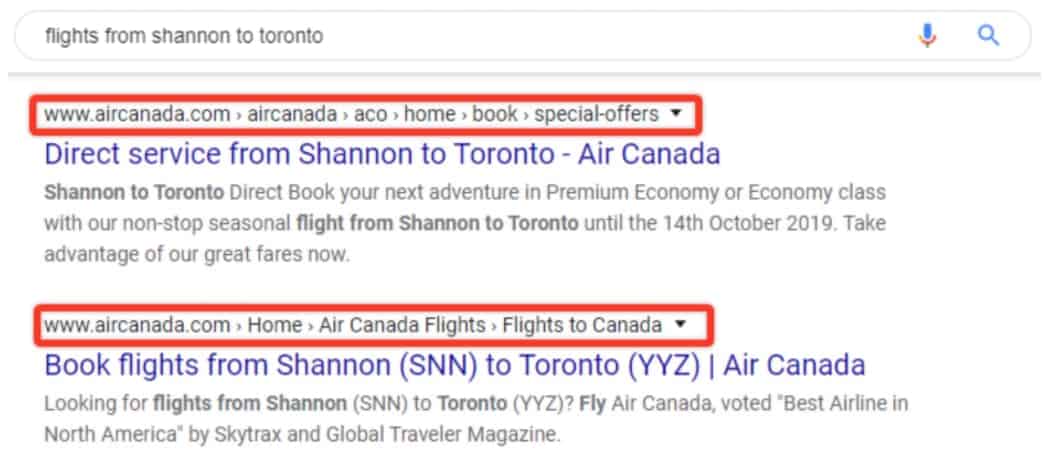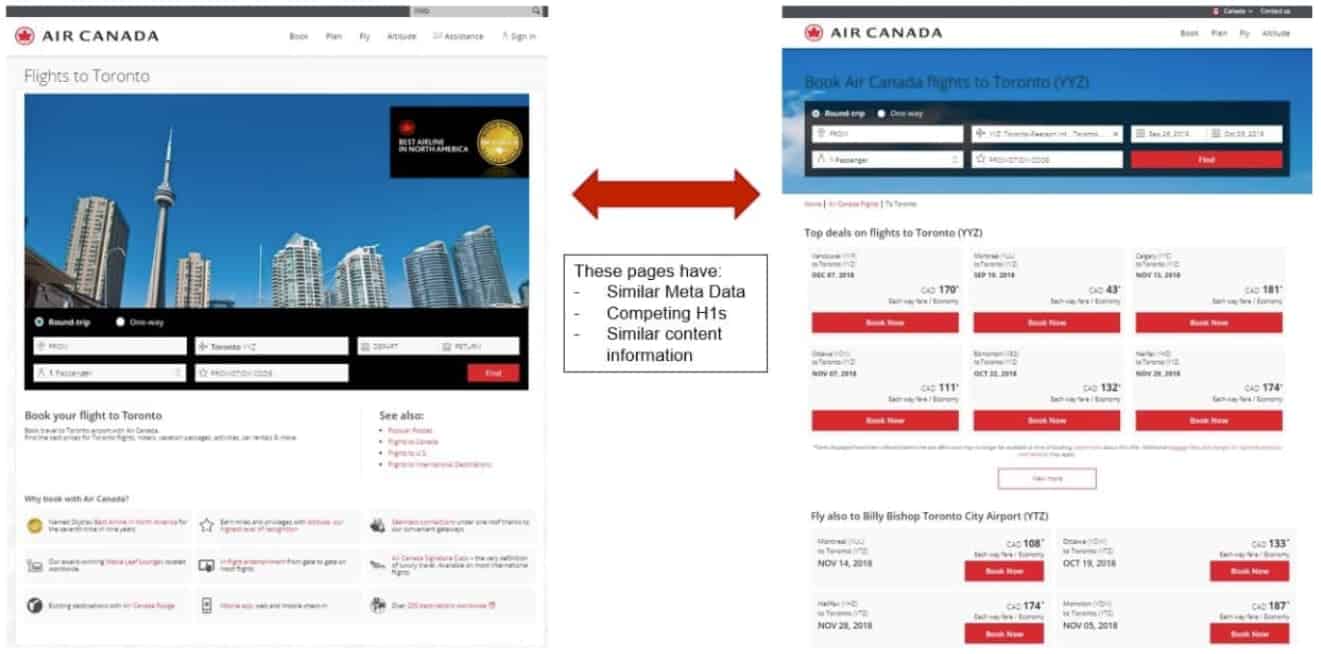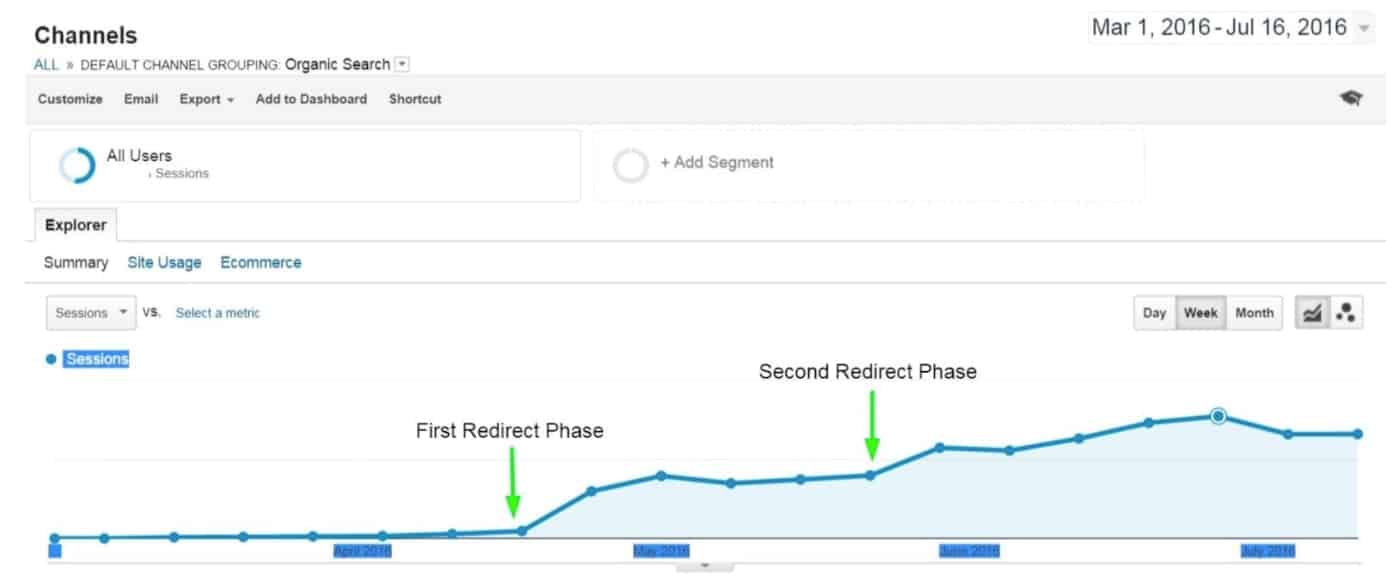This document offers best practices to prevent keyword cannibalization issues after launching airTRFX.
Back to SEO Resources for Airlines >
Who should read this document?
- Staff responsible for SEO
- Staff responsible for the airline’s website
- Staff responsible for making edits on airTRFX Control
Overview
Keyword cannibalization may occur when pages with similar content compete for the same keywords and search engines can’t determine which page to serve for such keywords.
This issue is very common to airlines’ websites where there usually are separate pages with very similar content, such as:
- Page 1: Promotional offers to [Destination]
- Page 2: Travel guide to [Destination]
- Page 3: Cheap flights to [Destination]
For example, on Air Canada’s website, there used to be several pages with very similar content competing in SERP. Before consolidating those pages as part of the airTRFX implementation, a search for “flights from Shannon to Toronto” would have shown two pages ranking in positions 2 and 3, like this:
When looking at two similar pages on Air Canada’s website, it is easier to realize why this was happening:
When the site does not use consistent canonicalization and site preference signals, keyword cannibalization may result in a myriad of negative effects:
- It can cause an undesirable page to outrank a desirable page.
- If cannibalizing pages convert worse than the airTRFX pages, you will be losing potential sales when users land on the cannibalizing pages.
- It can effectively drag down the rankings for all the competing pages.
- It can dilute the authority of the desirable page because internal and external links may point to several versions of the same content.
- It can cause inefficient crawling since search engines spend more time crawling the same content, leaving less time to discover new content.
Solutions
There are a couple of options to fix or prevent keyword cannibalization. Some work better than others, depending on several situational factors.
1. Content Consolidation (Recommended)
Merging content and implementing 301 redirects is the most effective way to prevent keyword cannibalization issues.
If the existing pages have a great potential to rank for the same keywords that the airTRFX pages can rank for, you should consider consolidating the similar pages and content into the most relevant airTRFX page. For example, a page showcasing “flights deals to Madrid’ has a high chance to compete in organic search against the airTRFX page targeting “flights to Madrid”. That’s because search engines are likely to serve both pages when users search for “flights to Madrid”.
Merging content is especially important if the cannibalizing pages contain highly useful information about the airline destination. This will consolidate the value of similar pages and enrich content on a single optimized airTRFX page.
Keep in mind that content consolidation requires the implementation of 301 redirects from the cannibalizing pages to the airTRFX pages.
By consolidating content and implementing 301 redirects, we will:
- Serve users and search engines with the preferred page.
- Improve the site’s conversion rates by serving a better-converting page to users.
- Prevent the dilution of link equity, page authority, and rankings.
- Serve unique content targeting unique search queries.
- Direct search engines to a single optimized page rather than to multiple similar pages, which could help search engines optimize their crawling resources.
- Funnel the backlinks impact to a single optimized page.
For example, the graph below shows the exponential growth in organic traffic for an airline after redirecting “travel guide” pages to the airTRFX flight pages:
Likewise, the Visibility Percent (metric from Advanced Web Rankings) for non-branded keywords with purchasing intent (e.g. “cheap flights to Toronto”) increased by 27% in 3 months:
As part of the airTRFX implementation program, our team will identify and provide you with the existing pages that have great keyword cannibalization potential. We will gather the pages in a Redirect Mapping spreadsheet, which maps out the potential redirects. At this point, we will discuss the plan to execute the content consolidation strategy.
2. Canonicalize (Might Work)
The canonical URL is the preferred URL in a set of variations. It’s the URL that you want search engines to serve in search.
A canonical tag is an HTML tag that looks like this:
<link rel=”canonical” href=”https://www.airline.com” />
This option can work when there are cannibalizing pages that you need to keep for some reason, but you want search engines to rank one of these pages over the other. Essentially, unlike content consolidation, canonicalization will keep the cannibalizing pages accessible to search engines and users while telling search engines which is the preferred page.
There is a big caveat about the canonicalization of similar pages, though. Google won’t guarantee that it will respect the canonical. In fact, Google can sometimes choose its own canonical regardless of the canonical declaration in the HTML.
Whether Google will respect the declared canonical or not boils down to the so-called “site preference signals”. The site preference signals are a mix of signals that Google factors in when selecting the preferred page in a set of similar pages. They include:
- Canonical annotations (the user-declared canonical)
- Redirects
- Internal linking
- URL in the sitemap file
- HTTPS preference
- “Nicer” looking URLs
- Hreflang
Typically, the existing pages with keyword cannibalization potential already have the site preference signals aligned around them. That’s because, generally, those pages have been around for a while. Thus, they may have incoming internal and external links, redirects pointing to them, or they may be in the site’s sitemaps.
This may complicate or delay Google’s processing of the canonical.
Additionally, keep in mind that search engines will keep spending crawling resources on the cannibalizing pages. Users can also land on these pages, which may affect the conversion rate negatively.
If content consolidation is not an option, our team will assess whether the canonicalization of the cannibalizing pages is a viable alternative. We will also provide the list of affected pages in the Canonicalization Mapping spreadsheet.
3. De-optimize (Low Impact)
This is an alternative when you can’t technically implement the canonicals or can’t consolidate the pages. De-optimizing simply means changing the page content and inbound links so the page does not rank for the keywords that airTRFX is targeting.
De-optimizing cannibalizing pages may entail:
- De-optimizing the content itself: removing references to the target keyword in the body content, page title, meta description, and headings.
- Changing the internal links (especially those with keyword-rich anchors): updating the internal links to the cannibalizing pages so they point to similar airTRFX pages. This is especially important for links with keyword-rich anchor texts.
- Creating internal links to airTRFX pages: embedding links on the cannibalizing pages to the corresponding airTRFX pages can also help!
The main problem with this option is that it won’t consolidate the link equity into a single optimized page. Search engines may also take a long time to demote the cannibalizing page in search results and promote the airTRFX page instead. And there is not even a guarantee that it will happen! Search engines will keep spending crawling resources on the cannibalizing pages. Users will keep accessing these pages, which could affect the conversion rate.
Back to SEO Resources for Airlines >
Further Reading
SEO Content Optimization for Airlines – EveryMundo
Canonicals and Site Preference Signals – EveryMundo
Consolidate Duplicate URLs – Google
Google Choosing Different Canonical – Google
How to Find and Fix Keyword Cannibalization Issues – Ahrefs
Keyword Cannibalization: How to Keep it From Harming Your On-Site SEO – SEMrush
Redirects – MOZ





